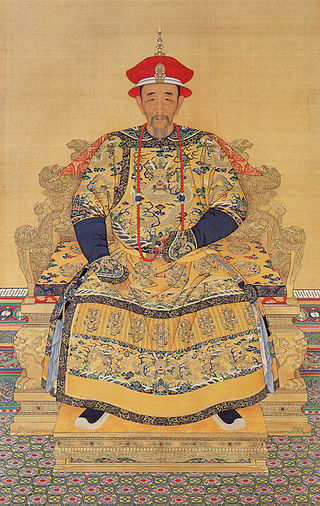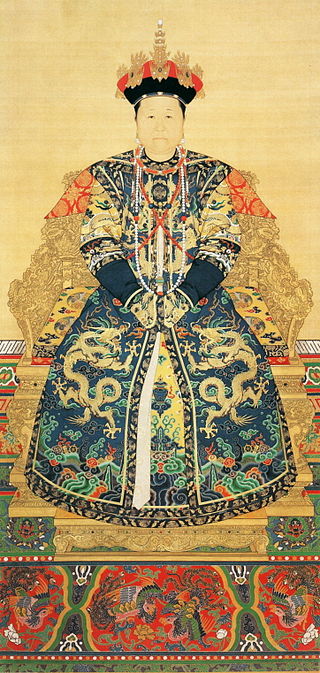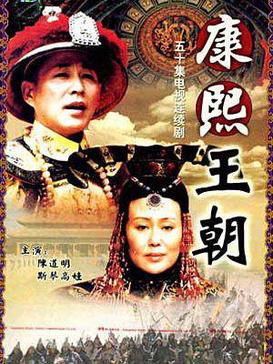Notes
This article includes a list of general references, but it lacks sufficient corresponding inline citations .(February 2009) |
The Four Regents of the Kangxi Emperor were nominated by the Shunzhi Emperor to oversee the government of the Qing dynasty during the early reign of the Kangxi Emperor before he came of age. The four were Sonin, Ebilun, Suksaha, and Oboi.
The Shunzhi Emperor died in 1661 and was succeeded by his six-year-old son, who was enthroned as the Kangxi Emperor. Before the Shunzhi Emperor died, he appointed four interior ministers – Sonin, Suksaha, Ebilun and Oboi – to assist the Kangxi Emperor as regents. This period of regency in the Qing dynasty was known as the "Four Regents period". The Kangxi Emperor only took full control of the government in May 1669.
In the initial stage of the regency, the four regents oversaw the government together and provided assistance towards each other in accordance with the Shunzhi Emperor's dying wishes. They continued the war against resistance forces loyal to the Ming dynasty (the dynasty before the Qing dynasty). In April 1662, the last ruler of the Southern Ming dynasty, the Yongli Emperor, was killed by Wu Sangui on the orders of the four regents. Within the next two years the Qing government had suppressed all anti-Qing armed forces within China. The Qing dynasty then moved on to a stable development phase as the society and economy had been badly devastated by war. The four regents devised policies to aid in the recovery and development of China.
During the early years of the regency, tension between the two Yellow Banners faction and Suksaha was kept in check by Sonin, and the four regents managed to maintain a relatively peaceful and efficient working relationship. However the dynamics of the regency began shifting as Sonin's health gradually deteriorated due to old age. As Sonin took more time off to recuperate, Oboi started monopolising state power by making decisions without consulting the other regents (taking advantage of Ebilun's indecisiveness) and sidelining Suksaha during discussions, especially on issues concerning the welfare of the Eight Banners.
By 1667, when Sonin realised that he did not have long to live, he attempted to restore balance to the regency and neutralise Oboi's rapidly expanding power clique. He wrote a memorial to the 14-year-old Kangxi Emperor, requesting that the emperor assume personal rule ahead of schedule. The Kangxi Emperor thus formally took over the reins of power in a ceremony on August 25, a month after Sonin's death. Following this, Kangxi issued an imperial decree to reduce the power of the three surviving regents, stating that their roles had been reduced to that of assisting ministers (佐政大臣). However even after officially taking full control of the government, the Kangxi Emperor found it difficult to curb Oboi's growing influence.
In 1669, with help from Grand Empress Dowager Xiaozhuang, the Kangxi Emperor had Oboi arrested and stripped off his position of power. [1] Since then, the Kangxi Emperor began taking personal control of the government. Ebilun was dismissed from office and Oboi's clique disbanded. This marked the end of the Four Regents period.
This article includes a list of general references, but it lacks sufficient corresponding inline citations .(February 2009) |

The Kangxi Emperor, also known by his temple name Emperor Shengzu of Qing, personal name Xuanye, was the third emperor of the Qing dynasty, and the second Qing emperor to rule over China proper, reigning from 1661 to 1722. His reign of 61 years makes him the longest-reigning emperor in Chinese history and one of the longest-reigning rulers in history. He is considered one of China's greatest emperors.

The Shunzhi Emperor was the second emperor of the Qing dynasty of China, and the first Qing emperor to rule over China proper, reigning from 1644 to 1661. A committee of Manchu princes chose him to succeed his father, Hong Taiji (1592–1643), in September 1643, when he was five years old. The princes also appointed two co-regents: Dorgon (1612–1650), the 14th son of the Qing dynasty's founder Nurhaci (1559–1626), and Jirgalang (1599–1655), one of Nurhaci's nephews, both of whom were members of the Qing imperial clan.

Bumbutai, of the Khorchin Mongol Borjigit clan, was the consort of Hong Taiji. She was 21 years his junior. She was honoured as Empress Dowager Zhaosheng during the reign of her son, Fulin, the Shunzhi Emperor, and as Grand Empress Dowager Zhaosheng during the reign of her grandson, Xuanye, the Kangxi Emperor.

Oboi was a prominent Manchu military commander and courtier who served in various military and administrative posts under three successive emperors of the early Qing dynasty. Born to the Guwalgiya clan, Oboi was one of four regents nominated by the Shunzhi Emperor to oversee the government during the minority of the Kangxi Emperor. Oboi reversed the benevolent policies of the Shunzhi Emperor, and vigorously pushed for clear reassertion of Manchu power over the Han Chinese. Eventually deposed and imprisoned by the new emperor for having amassed too much power, he was posthumously rehabilitated.
Soni (1601–1667), also known as Sonin, and rarely Sony, was a Manchu noble of the Hešeri clan who served as one of the Four Regents of the Kangxi Emperor during the Qing dynasty (1644–1912). His clan belonged to the Plain Yellow Banner.
Suksaha was a Manchu official of the early Qing dynasty from the Nara clan. A military officer who participated in the Manchu conquest of China, Suksaha became one of the Four Regents during the early reign of the Kangxi Emperor in the Qing dynasty (1644–1912). He eventually fell out with another regent, Oboi, and was sentenced to death.

Ebilun was a Manchu noble and warrior of the Niohuru clan, most famous for being one of the Four Regents assisting the young Kangxi Emperor from 1661 to 1667, during the early Qing dynasty (1644–1912). A largely passive figure during the regency, Ebilun was disgraced following the ouster of the far more powerful regent Oboi and considered a political supporter of the latter. He was stripped of his positions by the emperor but later regained his noble rank. Many of his descendants became influential figures in the Qing imperial government.

Kangxi Dynasty is a 2001 Chinese television series based on the novel Kangxi Da Di by Eryue He. The series is a prequel to the 1997 television series Yongzheng Dynasty, and was followed by Qianlong Dynasty in 2002.
Jirgalang or Jirhalang was a Manchu noble, regent, and political and military leader of the early Qing dynasty. Born in the Aisin Gioro clan, he was the sixth son of Šurhaci, a younger brother of Nurhaci, the founder of the Qing dynasty. From 1638 to 1643, he took part in many military campaigns that helped destroy the Ming dynasty. After the death of Huangtaiji in September 1643, Jirgalang became one of the young Shunzhi Emperor's two co-regents, but he soon yielded most political power to co-regent Dorgon in October 1644. Dorgon eventually purged him of his regent title in 1647. After Dorgon died in 1650, Jirgalang led an effort to clean the government of Dorgon's supporters. Jirgalang was one of ten "princes of the first rank" (和碩親王) whose descendants were made "iron-cap" princes (鐵帽子王), who had the right to transmit their princely titles to their direct male descendants perpetually.
The Deliberative Council of Princes and Ministers, also known as the Council of Princes and High Officials and Assembly of Princes and High Officials, or simply as the Deliberative Council, was an advisory body for the emperors of the early Qing dynasty (1644–1912). Derived from informal deliberative groups created by Nurhaci (1559–1626) in the 1610s and early 1620s, the Council was formally established by his son and successor Hong Taiji (1592–1643) in 1626 and expanded in 1637. Staffed mainly by Manchu dignitaries, this aristocratic institution served as the chief source of advice on military matters for Hong Taiji and the Shunzhi and Kangxi emperors. It was particularly powerful during the regencies of Dorgon (1643–1650) and Oboi (1661–1669), who used it to enhance their personal influence.
The history of the Qing dynasty began with the proclamation of the Qing dynasty by the Manchu chieftain Hong Taiji in 1636, but the year 1644 is generally considered the start of the dynasty's rule in China. The dynasty lasted until 1912, when Puyi abdicated the throne in response to the 1911 Revolution. The final imperial dynasty of China, the Qing dynasty reached heights of power unlike any of the Chinese dynasties which preceded it, engaging in large-scale territorial expansion which ended with embarrassing defeat and humiliation to the foreign powers whom they believe to be inferior to them. The Qing dynasty's inability to successfully counter Western and Japanese imperialism ultimately led to its downfall, and the instability which emerged in China during the final years of the dynasty ultimately paved the way for the Warlord Era.
Events from the year 1662 in China.
Events from the year 1661 in the Qing dynasty.
Events from the year 1663 in China. Also known as 壬寅 4359 or 4299 to 卯年 4360 or 4300 in the Earthly Branches calendar.
Events from the year 1664 in China. Also known as 癸卯年 4360 or 4300 to 甲辰年 4361 or 4301.
Events from the year 1666 in China.
Events from the year 1667 in China.
Events from the year 1668 in China.
Events from the year 1669 in China.